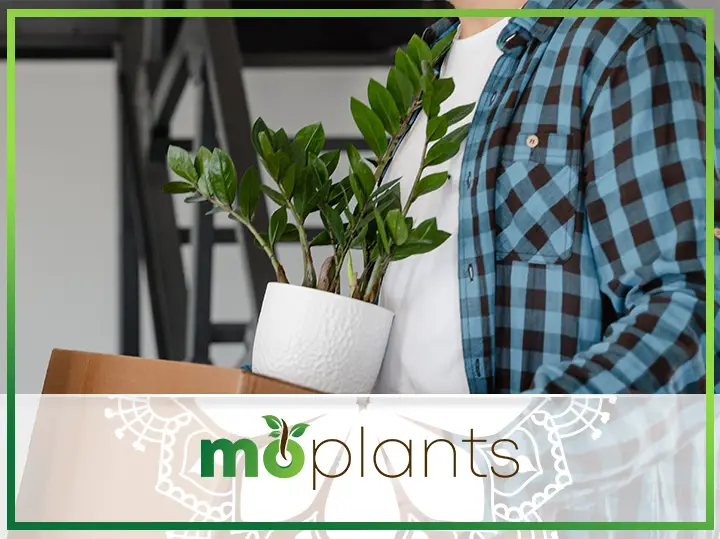As a plant enthusiast, you must have heard of the ZZ plant. If not, let us tell you that the Zamioculcas zamiifolia, aka ZZ, has quickly become the social media darling! The ZZ plant hails from Africa, where it is used to drought-prone conditions. While it has existed for a long time, it started gaining popularity only a few decades ago. Due to its little to no maintenance requirement and aesthetic appearance featuring attractive, dark green, waxy leaves, the ZZ plant is now ranked as one of the most wanted plants inside homes and offices.
The ZZ plant would make the perfect choice for your home, no matter where you live! It has a high tolerance for a variety of weather conditions. Even though the ZZ plant isn’t very picky or high-maintenance, there are some cardinal rules that you should remember when caring for it. Otherwise, you run the risk of problems like root rot, curling leaves, brown spots on leaves, and the trickiest of them all, light green leaves on a ZZ plant! If you think that is normal, read the post to learn more about this brilliant plant.
Reasons Behind Light Green Leaves In ZZ Plants
Most amateurs would tend to think that green leaves are not a cause of concern. In most cases, they aren’t. But when it comes to the ZZ plant, you need to worry a little. ZZ plant leaves are usually dark green in color. However, a young ZZ plant may have light green leaves, which is okay. After all, it’s still growing. These leaves will turn a darker color eventually. But if your ZZ plant’s dark green leaves start turning a lighter color, this could mean that they will eventually turn yellow. You should take notice of this early sign and work to save this precious plant. We’ll tell you how.
But first, let’s look at the common reasons behind the most googled phenomenon when it comes to the ZZ plant – light green leaves.
Lack of Nitrogen
If your ZZ plant gets inadequate nitrogen, the leaves will start to turn pale. The ZZ plant needs nitrogen to develop chlorophyll, a pigment that gives leaves their green color. If the plant does not have sufficient nitrogen, the leaves will naturally show a lighter green color.
Nitrogen deficiency is common in plants. Overwatering, due to excessive irrigation or heavy rainfall can result in insufficient nitrogen. In such an event, the plant won’t get the right amount of nutrients from the soil, resulting in visible effects on leaves. When it comes to the ZZ plant, light green leaves can become a common sight as opposed to its characteristic dark green if you continue to grow more ZZ plants in the same soil
Quick Solution
You can use a slow-release indoor fertilizer two times a year, during spring and fall. This fertilizer should last about 6 months. This way, you can ensure your plant has access to nutrients all year round.
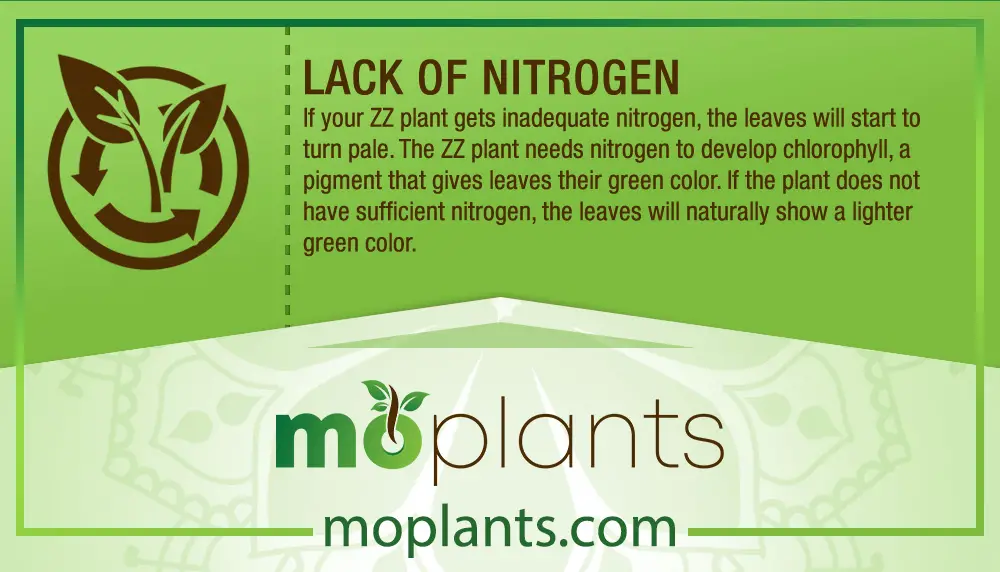
Insufficient Water
ZZ plants originate from Africa, so they are used to receiving little water. The ZZ plant also produces round rhizomes beneath the soil. These rhizomes can store water for a long time. However, this doesn’t mean they don’t need to be watered! A lot of people make this assumption, which can lead to the leaves turning a pale green color.
The ZZ plant leaves will show you signs of insufficient watering. There are signs that your plant is thirsty, including wrinkled leaves, wilting, and a dry potting mix. If you spot any of these signs, you should consider watering your plant.
Quick Solution
Follow a proper regime when watering the ZZ plant. If 50% of the topsoil feels dry to the touch, you should consider watering the plant. Make sure you deeply water the plant to maintain its health.
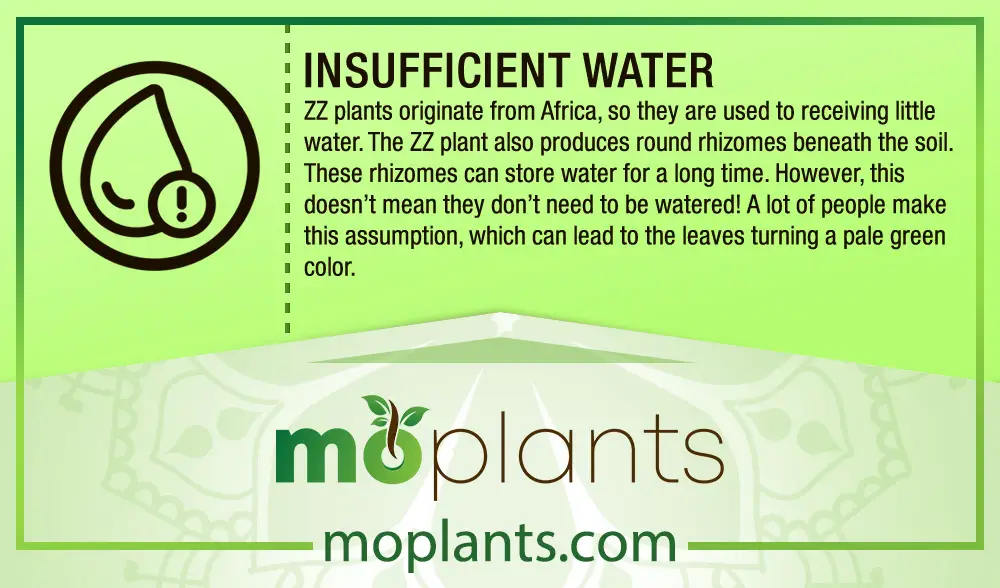
Overwatering
Overwatering is probably the most common reason why ZZ plants’ leaves turn light green. If you wish to keep a ZZ plant in your home, you need to replicate its natural habitat. The ZZ plant does not need much water to thrive. Overwatering the plant will cause the nitrogen to wash away. When the plant does not get enough nitrogen, the leaves will start to turn a light green color.
Overwatering will also cause oxygen to wash away from the soil, which will eventually cause stem rot or root rot. Damage to the plant’s root will render it unable to absorb nutrients. This lack of nutrients will lead to damaged leaves, which will manifest in the form of pale green leaves.
Quick Solution:
If you have overwatered your plant, you can repot it into a new, fresh and clean container to salvage it. This way, the ZZ plant will be able to access the nitrogen and oxygen, which will ensure it’s healthy and the leaves are a stunning, dark green color. Make sure you get rid of any fungus on the previous soil. Add a high-quality soil to the new pot, one that is recommended specifically for the ZZ plant.
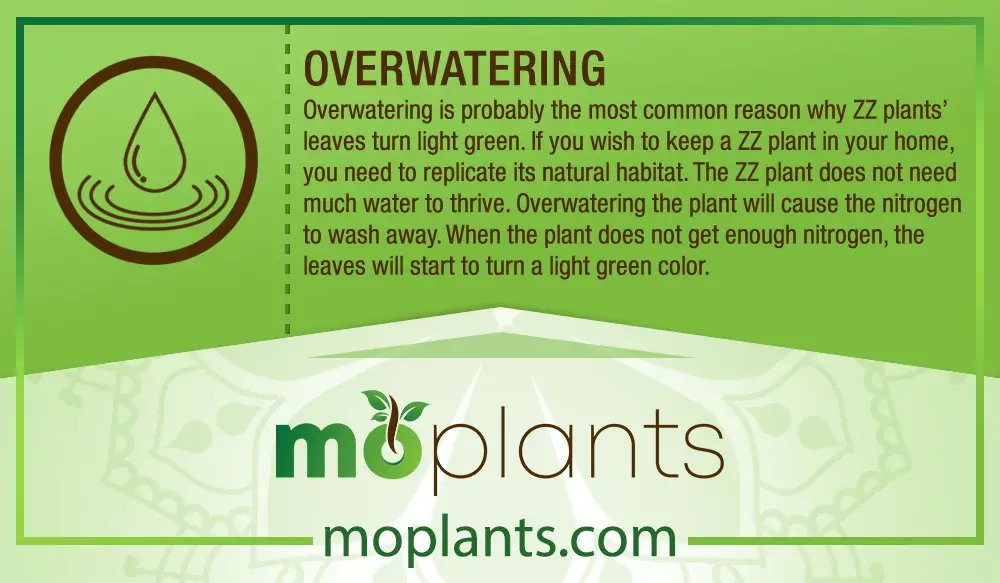
Excessive Exposure to Direct Sunlight
Given where the ZZ plant grows, it does not like too much direct sunlight. Overexposure to sunlight can damage the plant, turning its leaves a light green color. In fact, pale green or yellow leaves, and brown edges on leaves are a surefire sign of excess sunlight.
If you want to maintain the ZZ plant’s luxurious dark green leaves, you should make sure it gets indirect sunlight. Direct sunlight can be harsh and may scorch the ZZ plant’s leaves. The good thing is that this problem is easy to spot and fix.
Quick Solution:
You should read about caring for the ZZ plant before buying it. Ideally, you should choose a place in your home where the ZZ plant gets sufficient indirect sunlight. If you notice any of the signs of leaf damage, you can relocate your plant. Remove the brown leaves, but the light green leaves can be recovered by placing the plant in a relatively shaded corner.
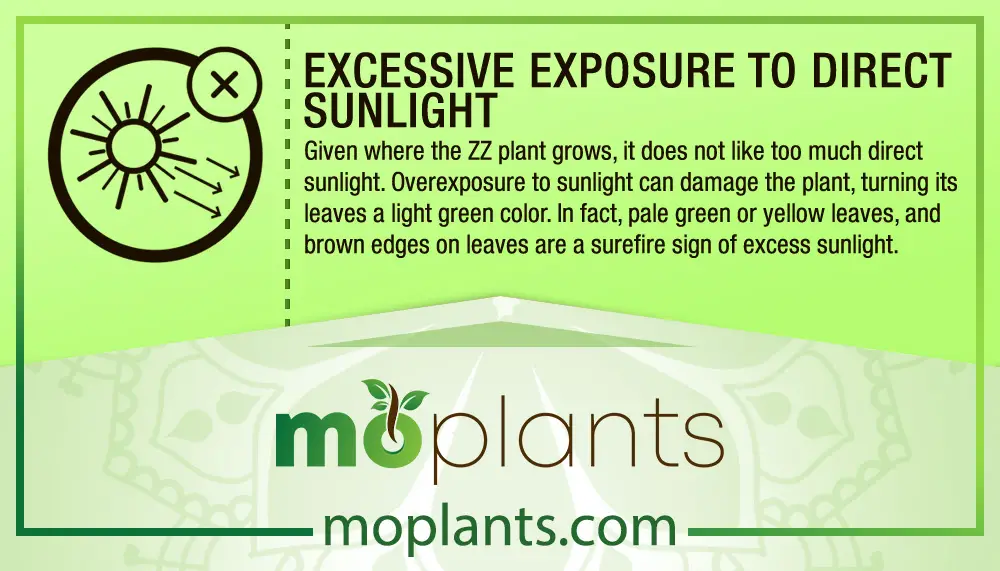
Old Age
If you have had the ZZ plant for a long time, you might notice that its leaves are now starting to lose their color. The dark green color might fade, and the leaves will turn a lighter green, even yellow. This is one of the signs of an aging ZZ plant. Since old age cannot be dodged, you shouldn’t worry too much.
In such an event, the only thing that you should do is consider propagating the ZZ plant. This way, you can enjoy new ZZ plants and fresh leaves, now that the old one is close to expiring. The ZZ plant can live up to 5-10 years, and even longer under the right conditions, so you won’t worry about this problem anytime soon!
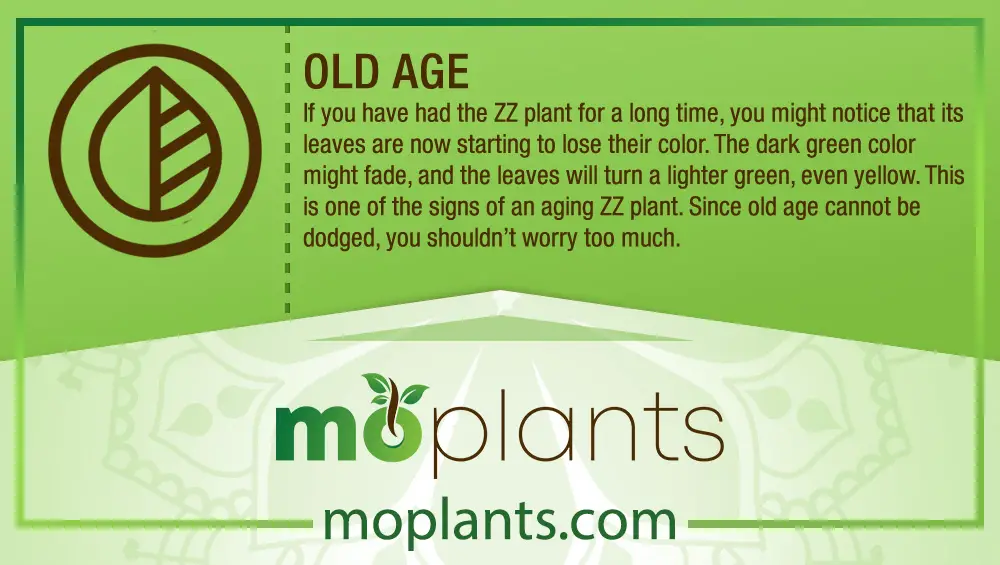
Infographic
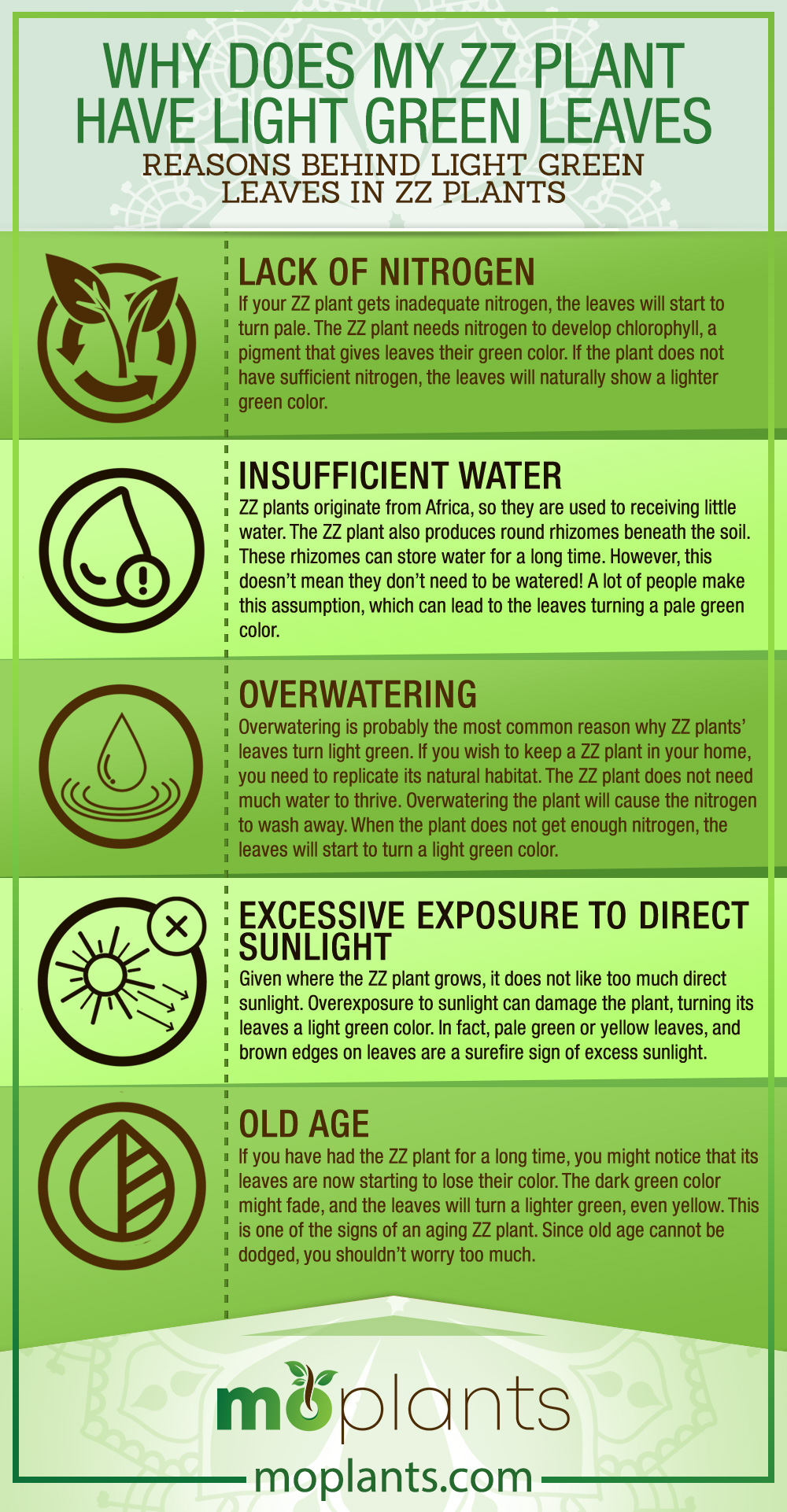
How to Avoid Light Green Leaves In ZZ Plant?
A healthy ZZ plant is identified by its shiny, dark green leaves. This unfussy, tropical perennial plant has 91% leaves. The plant can survive in poor conditions for about 6 months. But even during this time, you might start to see some signs of damage, chief of which are light green leaves.
Now that we have identified the causes of the ZZ plant’s light green leaves and drafted quick solutions to salvage it, we need to understand how to avoid this phenomenon altogether. If you care for this long-living plant the way it is meant to be cared for, you can enjoy its presence for years to come.
Do Not Overwater Your ZZ Plant
The ZZ plant originates from Africa, where it does not receive much rainfall. As a result, it cannot withstand overwatering. Ideally, you should water your ZZ plant every 2 to 3 weeks or until it starts showing signs of being thirsty. You should let the soil dry out between each watering. The ZZ plant’s rhizomes can store water and prove sufficient in between each watering session.
Moreover, you should water the plant more frequently when it is in bright light and less frequently when it is in low light conditions. In winter, the plant would need to be watered once a month, which is less than what it would need during spring or summer. If you notice that the topsoil is dry to touch, this is a sign that the ZZ plant needs moisture. Ensuring this watering frequency will prevent your ZZ plant’s leaves from turning a light green color.
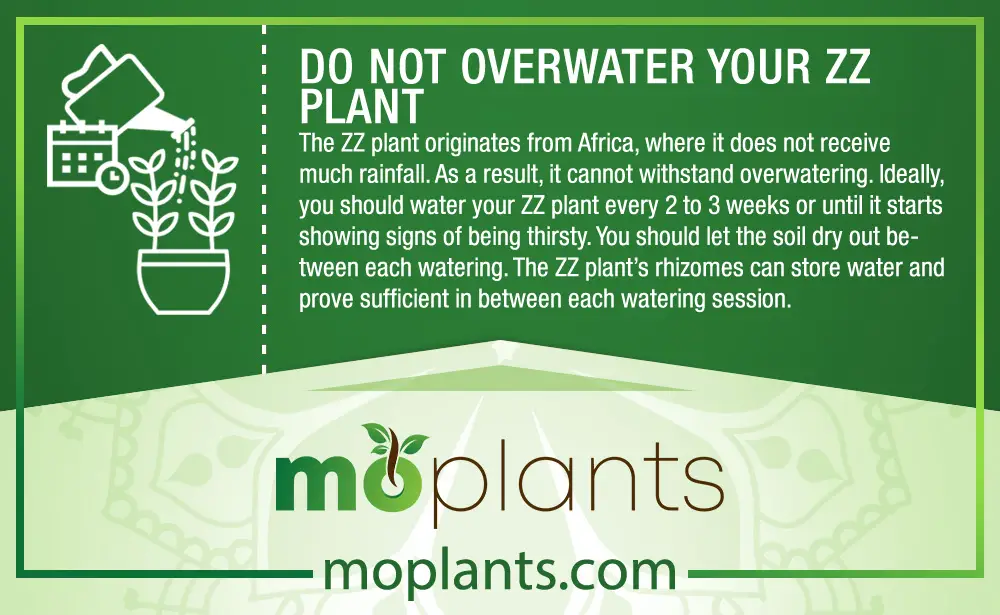
Do Not Place The ZZ Plant in Direct Sunlight
The ZZ plant is tolerant to indirect sunlight, but overexposure to direct sunlight can cause the leaves to turn a light green color. Ideally, the ZZ plant should have access to medium to indirect sunlight. This could range between 6 hours of sunlight per day during winter, and a maximum of 12 hours of indirect sunlight during the warmer months. Anything more than that can prove devastating for the ZZ plant.
If your plant lives indoors, make sure you do not place it in a spot where it gets direct, harsh sunlight. You can place a sheer drape or curtain if it is on a windowsill to shield it from direct sunlight. Place it in a well-lit spot during the day and perhaps under an LED light at night. This will save the leaves from losing their color. You can even install grow lights, but they may be a costlier option.
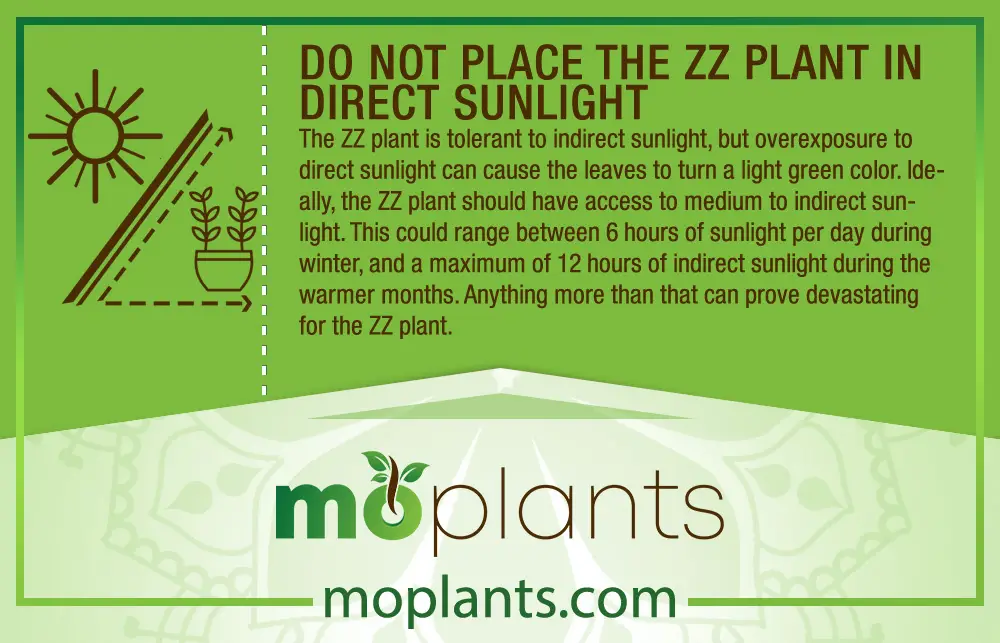
Fertilize Regularly
Access to insufficient nutrients can cause the ZZ plant leaves to turn a pale green color. Therefore, it is important to provide your plant with its regular supply of nutrients to prevent this problem altogether. The growth of the ZZ plant is relatively slower, so the frequency of fertilizing wouldn’t be that high. Ideally, you should aim to fertilize it every 3 to 6 months. Of course, this would change depending on the size of the ZZ plant.
You should also choose nitrogen-based fertilizers for the plant. The nitrogen will boost foliage, which will ensure the new leaves have a dark green color. When you repot the plant, use new soil that is able to supply the ZZ plant with the nitrogen and oxygen it needs.
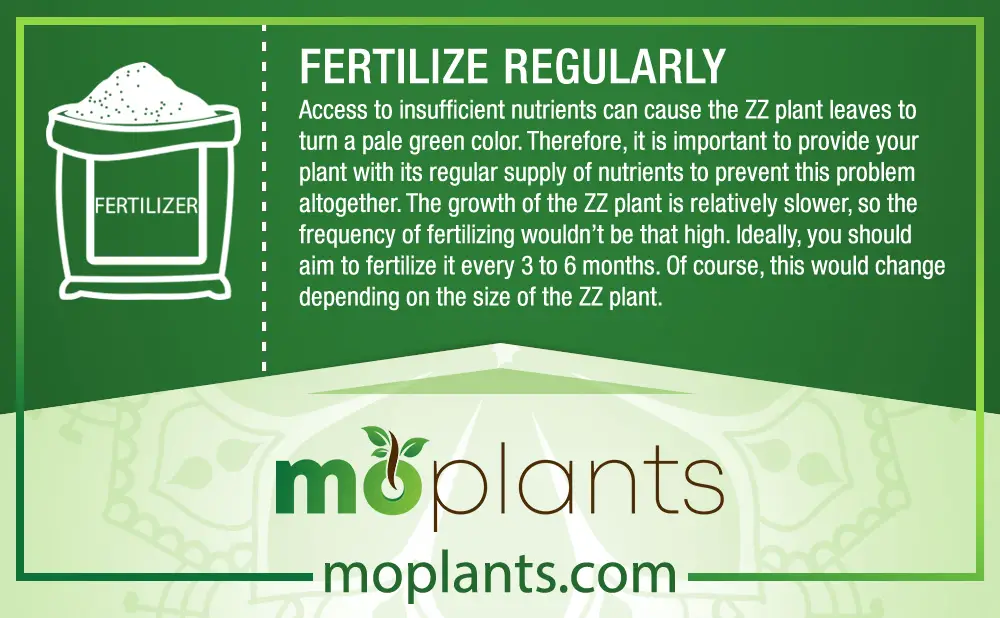
Check for Signs of Underwatering
As we mentioned above, the ZZ plant leaves will turn light green if the plant is thirsty. Most people think overwatering is the only issue with the plant, but that’s clearly not the case. You need to maintain a balance between underwatering and overwatering, which can be a little tricky.
You should check the ZZ plant for any signs of underwatering. One way is to touch the topsoil. If at least half of it is dry, you need to water it, especially in the growing phase. You should irrigate an underwatered plant till water starts to pour out from the drainage holes. However, do not try this normally or repeat this as the ZZ plant can be very sensitive to excess moisture.

Repot the Plant if Required
If the ZZ plant leaves turn light green, you should consider repotting the plant. This can save the plant before the leaves turn completely brown and need to be pulled out. You can try out the different solutions we gave above depending on the problem you’re facing. You may then proceed to repot the plant to bring some improvement in the plant growth and leaf health.
Make sure the new container is clean and new. It should not contain any of the damage that the previous plant had, like fungus. Add new, ZZ plant friendly soil to the container. This way, you’ll ensure the plant is able to access all the nutrients it needs to thrive.
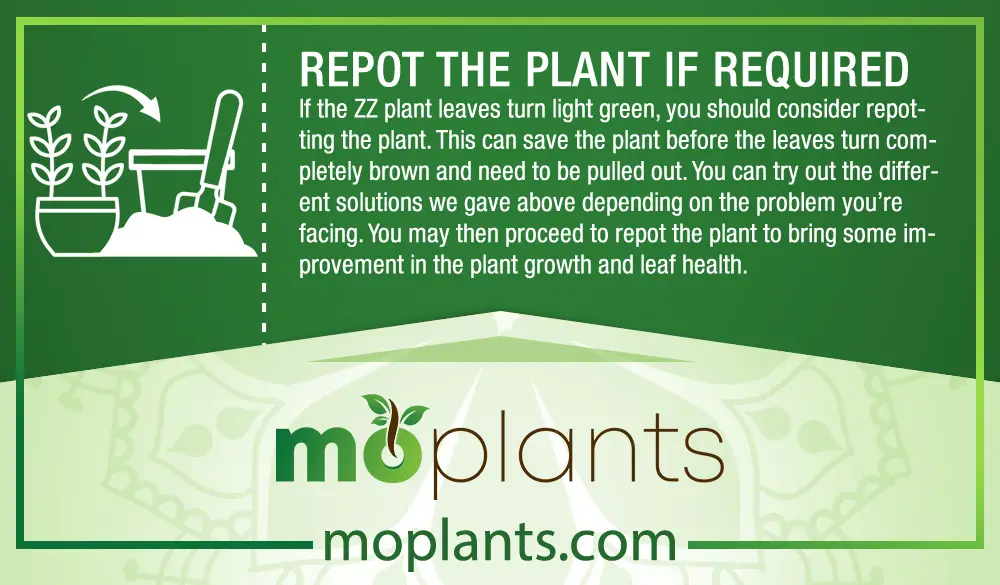
Infographic
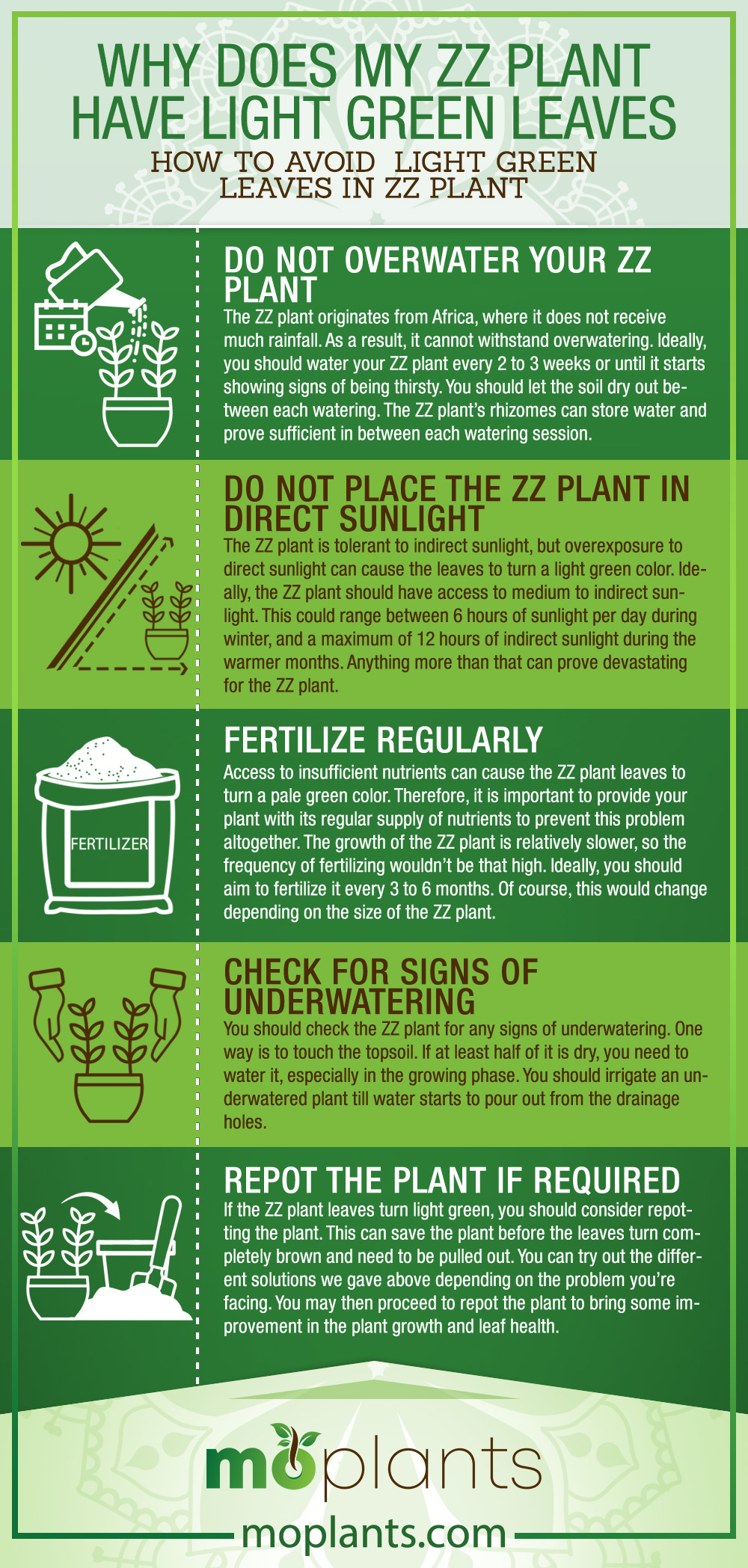
FAQ’s
What Causes Light Green Leaves In ZZ Plant?
There are many reasons why your ZZ plant’s leaves may be turning light green. This may be due to insufficient nutrients, lack of water, overwatering, too much direct sunlight, and old age.
Can I Turn Light Green Leaves Dark Green Again?
Yes, if you notice the issue early on and tend to it immediately. Repotting the plant will also produce new foliage with dark green leaves.
When Should I Be Concerned About Light Green ZZ Plant Leaves?
A ZZ plant will have light green leaves when the plant is still growing. You should be concerned if the existing dark green leaves start to turn pale.
Conclusion
The ZZ plant has stunning foliage, is easy to maintain, and can brighten up the look of any indoor space. It can last up to a decade or even more, which is why people love it. To make this possible, you need to properly care for it. Failure to do so will cause a number of problems, including light green leaves. When it comes to the ZZ plant, light green leaves are a result of insufficient nitrogen, overwatering or underwatering, direct sunlight, and old age. You should act as soon as you notice light green leaves, as they will quickly turn yellow, and then brown. Make sure you have all the correct information about how to care for the ZZ plant to ensure its longevity and good health.

